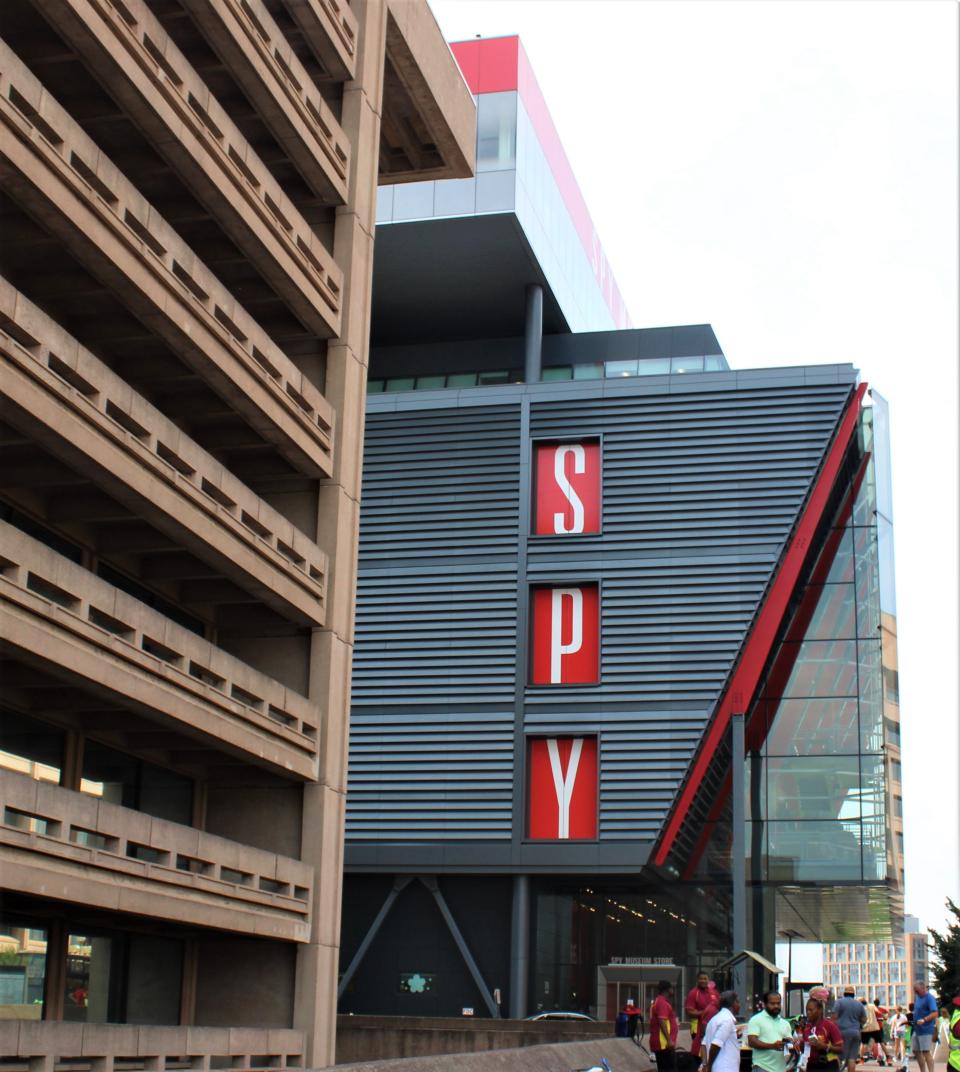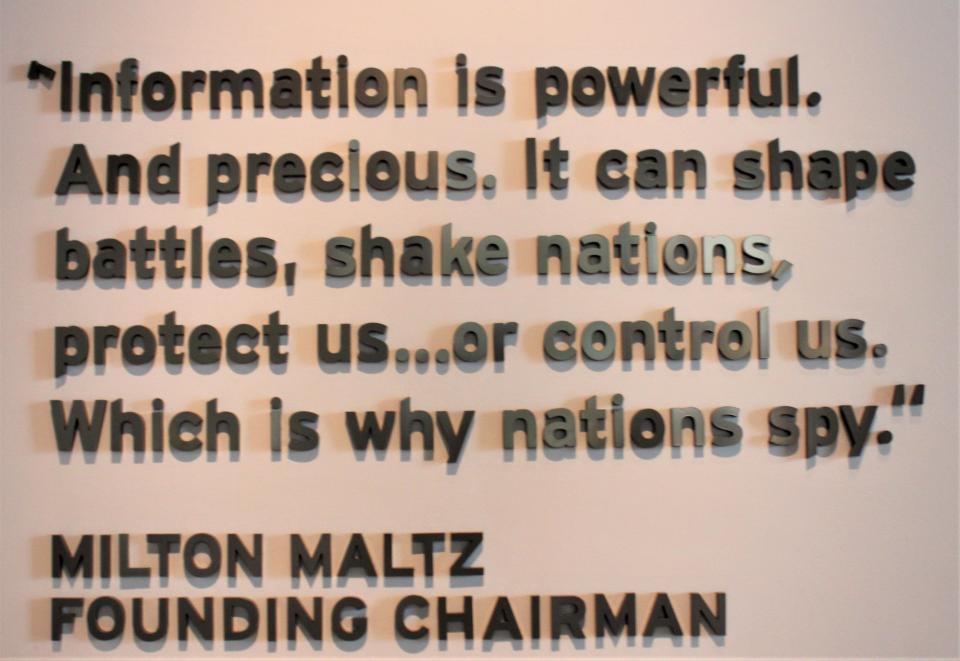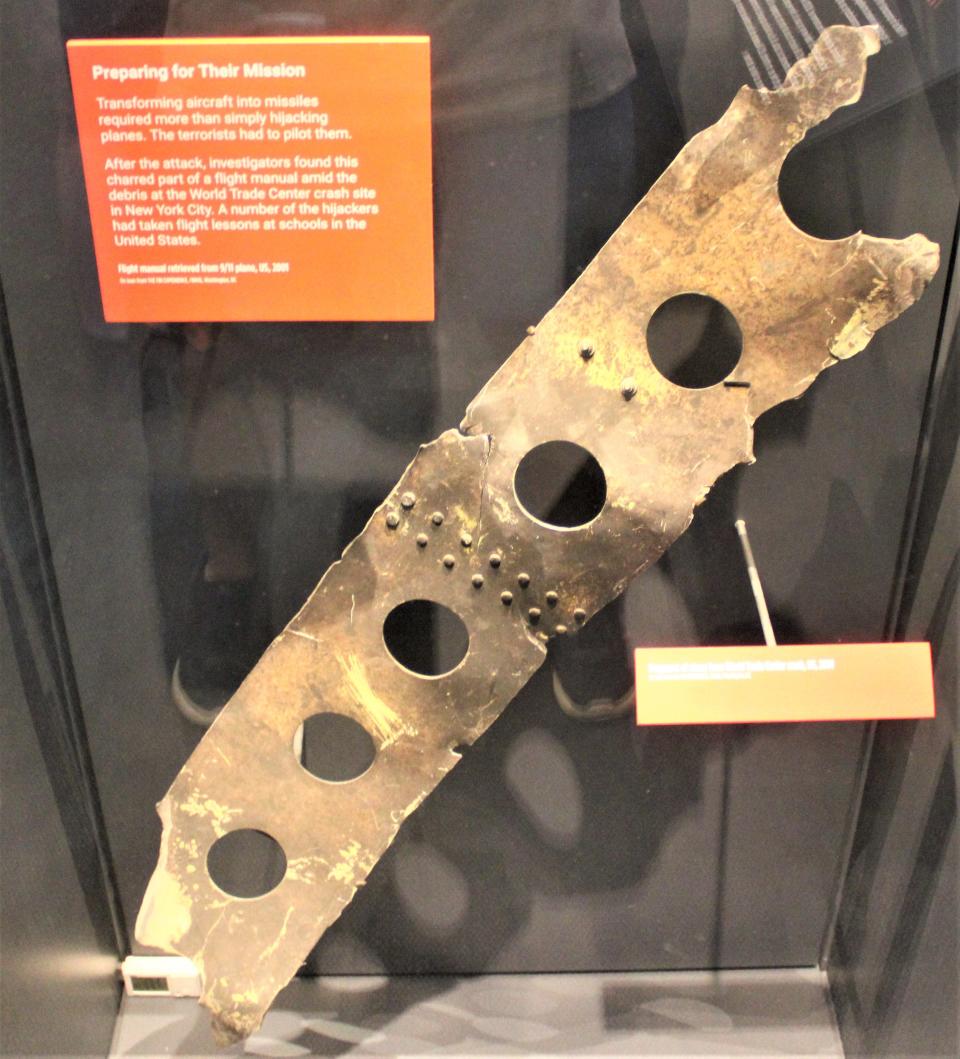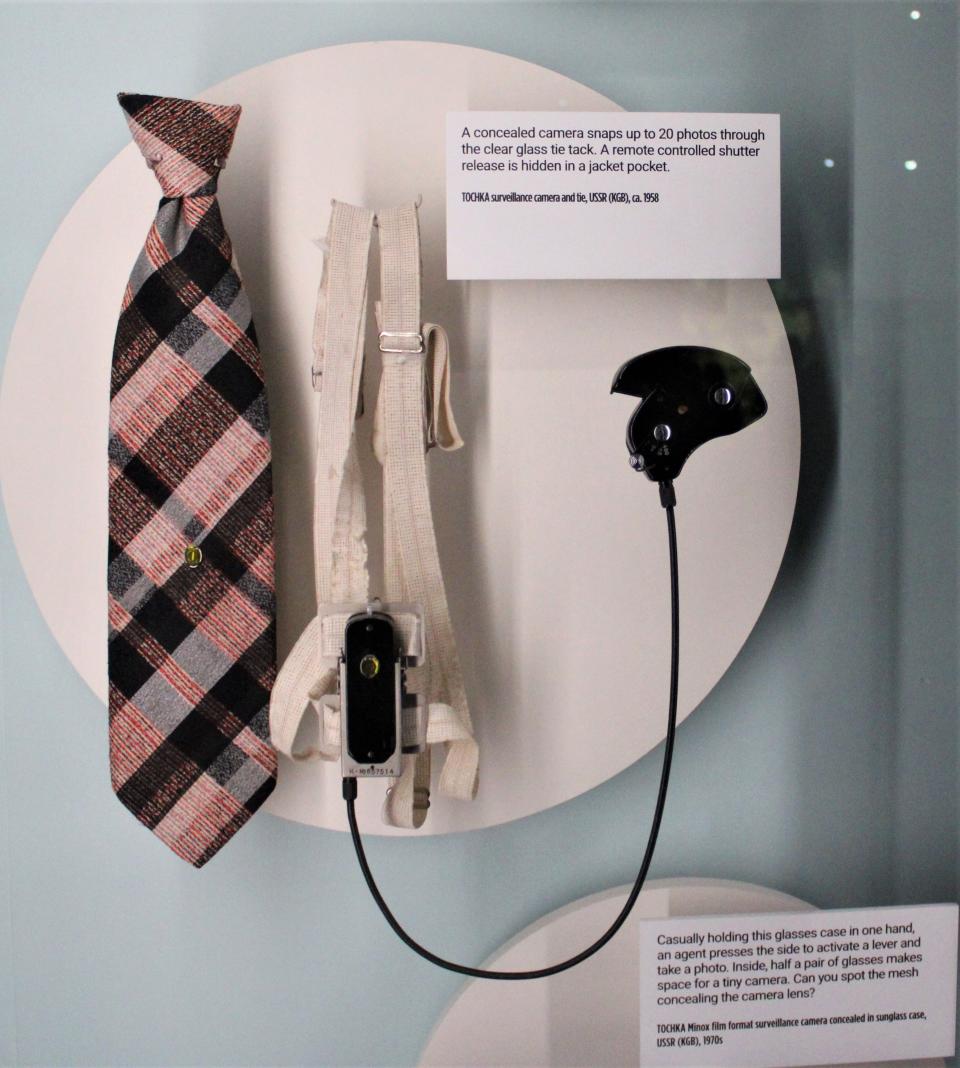My code name: Fangtooth. Beyers Byways hits the spy museum
- Oops!Something went wrong.Please try again later.
My cover name was Micha Styen, a pilot from San Jose, Costa Rica and I was flying to Christchurch, New Zealand.
My mission: to learn if one of our agents was a traitor and willing to sell out the country's secrets for $600,000.
My code name: Fangtooth.
I accepted the mission and outfitted myself with the perfect disguise to match my character.
“You look like a walrus with a huge mustache and aviator glasses,” remarked my darling wife, Laureen, a keen observer of detail.
“Don’t look in my direction,” Styen (me) replied. “I don’t want others to notice me.”
Laureen shook her head. “If that’s not a bad imitation of a walrus then it’s a worse one of Geraldo Rivera. Oh, you’ll be noticed, but probably left alone.”
Without turning my head, I noticed no one was aware of me in all 360 degrees. That is how secret agents work. Eyes, not only in the back of our heads, but all around our cranium like a sweatband.

“I’m off,” I said. The mission was important, and Laureen had gotten her new identity, disguise, and had her own orders.
I didn’t know who she was, what she looked like, or her mission. Spies are like that - plus it did not really matter to me.
I was a man on a mission, literally.
The International Spy Museum in Washington D.C. is a must for anyone with curiosity about what it would be like to be an actual spy.
Yes, spies like James Bond 007, with the license to kill and woo beautiful women. Not sure he actually had a license about the wooing stuff, but it didn’t seem to slow the man from the British Agency, MI6.
“I’m Bond, James Bond,” the handsome secret agent would say. “And I like my Martinis shaken, not stirred.”
“Dude, I’m a taxi driver and just wanted to know what hotel to drop you off at,” a cabbie may have once said in return. “Nice accent though.”
This modern-styled building sits not far from the capitol and is an easy jaunt on the subway from pretty much anywhere in the D.C. area.
The museum mission statement: ‘Come face to face with spies and spymasters, the gadgets and engineers, stories from past and present. With two floors of interactive exhibits to tap, touch, and play - you don’t visit SPY, you live it.’

And live it we did.

The first-floor entry has spy paraphernalia for the visitor to gawk at before checking in with Control.
A huge drone hanging from the tall ceiling with a Cro Magnon man staring at it from a nearby tree. Why? No idea. One of the first underwater submarines, the Bushnell Turtle, used to sneak up on a ship and plant an early style mine, thus blowing up said ship. A piece of the wreckage from Gary Powers ill-fated U-2 mission over the Soviet Union. The Sleeping Beauty submersible from 1943. And the iconic Aston Martin DB5 used in the 1964 Bond film, Goldfinger.
Laureen had to tear me away from the silver beauty.
“But it has actual working machine guns, tire slashers, a bullet proof rear screen, and revolving license plates.”
“Yes, but they are calling our names for entry.” Laureen replied. “You can continue to drool over the car on our way out.”
I was going to hold her to that promise.
We met our first contact, a pleasant young man who explained that we were about to enter the world of espionage and that we should never trust anyone.
I looked at Laureen.
“He doesn’t mean me.”

The two of us entered the elevator and headed to the fifth floor - the briefing center - where we would assume new identities, receive our orders, and execute said orders.
“That was easy,” I said. “Except for my disguise.”
“I told you to minimize the glasses and mustache,” she replied. “But did you listen to me?”
“What?”
The two floors of the museum are huge and there are signs on the floors to direct the visitors to their missions while viewing the thousands of actual spyware gadgets that are on display, as well as the detailed information concerning each item.
There is a letter from George Washington, when he was commander of the armed forces during the Revolutionary War, the father of the first actual spying agency for the new country.
Washington is known as the OG American spy.
Then, there was a 1965 KGB lipstick pistol on display. Talk about the kiss of death.
Pigeons used to carry around some pretty heavy camera equipment during World War I, and one such example is there to wonder about. How did they snap each photograph of the enemy while flying over the battlefields?
And there was something that seemed it could have been from Maxwell Smart: a shoe transmitter in the heel from the 1960s, used in Eastern Europe. Like that would be a secret, seeing someone in a coffee shop speaking into the bottom of their shoe.
The museum went on and on, perfectly laid out for the guests. Exhibit after exhibit describing why spying has always been part of the human experience.
It is not a modern phenomenon. Moses spied on Ramses II. Ramses II spied on Moses. Moses spies spied on Ramses II’s spies - and it just kept going.
An entire section is geared for famous female spies from different time periods and areas around the globe called the Sisterhood of Spies. Mata Hari, Harriet Tubman, Virginia Hall, and Marlene Dietrich to name just a few.
Actually, I named four.
The museum opened in 2002 in the Penn Quarter area of Washington D.C. but as it became more and more popular and their inventory grew, they had to move to the new ultra-modern building in 2019 at L’Enfant Plaza.
As we walked the floors of the museum marveling at how ingenious humans can be with gadgets to spy on one another, we also had to continue on with our individual missions.
Being an interactive museum and me being a non-interactive guy, Laureen had to guide me through the process of getting ready for the missions in which we would soon partake.
There are numerous interactive stops where I had to insert my ID card and receive updates or concerns about the person I was spying on. There were also tests to check my memory skills, math skills, acuity skills and the like. I passed each one but there was usually a blaring yellow indicator that sneered ‘you passed but you ain’t no James Bond.’
One of the more interesting concepts of the Spy Museum are the holograms of individuals who tell their story of being a spy and the result of that spying.
A man sitting on a cot inside a prison cell in Siberia describes how he was once the toast of Moscow. His country loved him but when dictators changed, as they do in communist countries, he was no longer the toast, but simply the crust.
Another told her story of living the glamorous life of a dancer, Mata Hari, and how she was executed by the French during World War I for being a spy for Germany. In reality, she was obtaining secrets from the Germans and passing them onto the French.
Each simulation was a couple of minutes but portrayed folks who were once just people and then turned spy. None seemed to end happily.
Of course, there were exhibits of American spies who sold out the United States for profit. The likes of Benedict Arnold, Ethel and Julius Rosenberg, Edward Snowden, and John Walker. Unfortunately, there were many more Americans selling out fellow Americans and they were there for all to see their betrayals.
Each of the two floors with exhibits is exciting, insightful, and just fun.
Families with kids, families without kids, and even kids wandering about seemingly without families, were intrigued on learning this or that about the world of espionage and how it worked and is still working to this day.
One thing we learned is that humans will always spy on fellow humans when they find it to their benefit.
The International Spy Museum points that fact out at each turn down its long hallways and vivid displays.
Laureen and I finished our missions and resolved the issue at hand.
“Now, for our reward,” Laureen, code name Turquoise, announced.
“An adult libation toast for succeeding?”
“Perhaps after a visit to the gift shop.”
I did not need to be a master spy to know that was in the near future.
Did I say Turquoise? Her code name should have been Debit Card.
For more information: https://www.spymuseum.org/
John can be contacted at beyersbyways@gmail.com
This article originally appeared on Visalia Times-Delta: My code name: Fangtooth. Beyers Byways hits the spy museum

